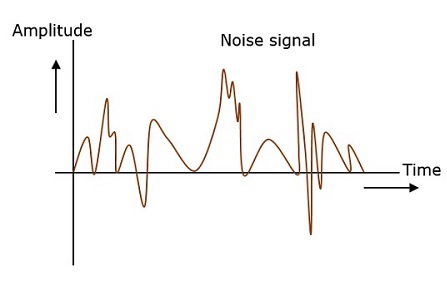
- Transistors - Overview
- Transistor Configurations
- Transistor Regions of Operation
- Transistor Load Line Analysis
- Operating Point
- Transistor as an Amplifier
- Transistor Biasing
- Methods of Transistor Biasing
- Bias Compensation
- Amplifiers
- Basic Amplifier
- Classification of Amplifiers
- Based on Configurations
- Multi-Stage Transistor Amplifier
- RC Coupling Amplifier
- Transformer Coupled Amplifier
- Direct Coupled Amplifier
- Power Amplifiers
- Classification of Power Amplifiers
- Class A Power Amplifiers
- Transformer Coupled Class A Power Amplifier
- Push-Pull Class A Power Amplifier
- Class B Power Amplifier
- Class AB and C Power Amplifiers
- Tuned Amplifiers
- Types of Tuned Amplifiers
- Feedback Amplifiers
- Negative Feedback Amplifiers
- Emitter Follower & Darlington Amplifier
- Noise in Amplifiers
- Amplifiers Useful Resources
- Amplifiers - Quick Guide
- Amplifiers - Useful Resources
- Amplifiers - Discussion
Noise in Amplifier
An Amplifier, while amplifying just increases the strength of its input signal whether it contains information or some noise along with information. This noise or some disturbance is introduced in the amplifiers because of their strong tendency to introduce hum due to sudden temperature changes or stray electric and magnetic fields.
The performance of an amplifier mainly depends on this Noise. Noise is an unwanted signal that creates disturbance to the desired signal content in the system. This can be an additional signal that is produced within the system or can be some disturbance accompanied with the desired information of the input signal. However, it is unwanted and has to be removed.
A good system is one in which the noise generated by the amplifier itself is small compared to noise from the incoming source.
Noise
Noise is an unwanted signal which interferes with the original message signal and corrupts the parameters of the message signal. This alteration in the communication process, makes the message to get altered after reaching. It is most likely to be entered at the channel or the receiver.
The following graph shows the characteristics of a noise signal.

Hence, it is understood that noise is some signal which has no pattern and no constant frequency or amplitude. It is quite random and unpredictable. Measures are usually taken to reduce it, though it cant be completely eliminated.
Most common examples of noise are −
- Hiss sound in radio receivers
- Buzz sound amidst of telephone conversations
- Flicker in television receivers etc.
Effects of Noise
Noise is an inconvenient feature which affects the system performance. The effects of noise include −
Noise limits the operating range of the systems − Noise indirectly places a limit on the weakest signal that can be amplified by an amplifier. The oscillator in the mixer circuit may limit its frequency because of noise. A systems operation depends on the operation of its circuits. Noise limits the smallest signal that a receiver is capable of processing.
Noise affects the sensitivity of receivers − Sensitivity is the minimum amount of input signal necessary to obtain the specified quality output. Noise effects the sensitivity of a receiver system, which eventually effects the output.
Signal to Noise Ratio
When a signal is received and it has to be amplified, first the signal is filtered out to remove any unwanted noise if available.
The ratio of the information signal present in the received signal to the noise present is called as Signal to Noise ratio. This ratio has to be higher for a system so that it produces pure information signal unaffected by the unwanted noise.
The SNR can be understood as
$$SNR = \frac{P_{signal}}{P_{noise}}$$
SNR is expressed in logarithmic basis using decibels.
$$SNR_{db} = 10 log_{10}\left (\frac{P_{signal}}{P_{noise}} \right )$$
Signal-to-noise ratio is the ratio of the signal power to the noise power. The higher the value of SNR, the greater will be the quality of the received output.
Types of Noise
The classification of noise is done depending up on the type of source, the effect it shows or the relation it has with the receiver etc.
There are two main ways of which noise gets produced. One is through some external source while the other is created by the internal source, within the receiver section.
External Source
This noise is produced by the external sources which may occur in the medium or channel of communication, usually. This noise cant be completely eliminated. The best way is to avoid the noise from affecting the signal.
Most common examples of this type of noise are −
- Atmospheric Noise (due to irregularities in atmosphere)
- Extra-terrestrial noise such as solar noise and cosmic noise
- Industrial noise
Internal Source
This noise is produced by the receiver components while functioning. The components in the circuits, due to continuous functioning, may produce few types of noise. This noise is quantifiable. A proper receiver design may lower the effect of this internal noise.
Most common examples of this type of noise are −
Thermal agitation noise (Johnson noise or Electrical noise)
Shot noise (due to random movement of electrons and holes
Transit-time noise (during transition)
Miscellaneous noise is another type of noise which includes flicker, resistance effect and mixer generated noise, etc.
Finally, this gives an overall idea on how a noise will be and how it can affect the amplifier, though present in transmitter or receiver section. The amplifiers that amplify low signals and hence amplify noise in a low level can be called as Low-noise amplifiers.
All the types of amplifiers discussed are more or less subjected to noise in some way or the other. The performance of an amplifier determines its efficiency to deal with the unwanted factors.